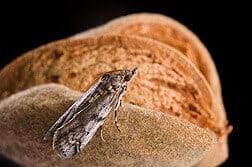A U.S. Department of Agriculture (USDA) entomologist in California is helping growers evaluate a new lure designed to monitor for infestations of navel orangeworms (NOW), the number-one pest of almonds and pistachios and a major pest of walnut. The work by Charles Burks, who is with the Agricultural Research Service (ARS) in Parlier, could also help reduce insecticide use on the 1.3 million acres where $7 billion worth of almonds, pistachios and walnuts are grown each year.
Some growers use traps supplied with almond meal to attract NOW. Known as egg traps, they require growers to count eggs left by mated females who have visited the traps. But counting eggs is labor intensive and notoriously unreliable. Instead of almond meal, the new NOW BioLure® uses a complicated blend of synthesized female pheromones to attract males. It can be used with a variety of traps and is easier to use.
Burks and his colleagues compared the number of NOW captured in a commonly used trap baited with either the new lure or unmated females placed in mesh bags. The study involved experiments in almond and pistachio fields, each running about 2 to 3 months. Unmated females had to be replaced every 4 days to ensure they were alive—since they were being used as the bait. Results, published in the journal Insects in July 2014, showed the female bait captured more insects than the new lure (353 vs. 212 overall), but the lure attracted insects for 40 days.
They also compared capture results using three different types of traps baited with either the lure or live females. They placed traps at a variety of distances from each other and counted “single night” captures and capture rates over a four-month growing season. The results, published in the Journal of Economic Entomology in February 2015, showed that trap design and trap density, or the spacing between traps, are important factors. Along with previous studies on egg traps, the work shows that the lure does not trap as many NOW as female-baited traps, but it is an improvement over egg traps. It also shows that the right trap and the optimal trap density will vary, depending on a grower’s needs.


